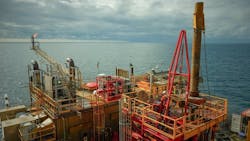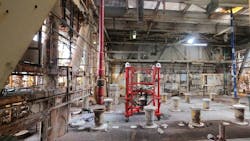Well P&A method aims to address ESG concerns
Steven Allan Canny * Weatherford
Increasing energy demand from the growing global population continues to drive operators to maximize hydrocarbon recovery from existing reserves and wells. In the past, this hunger for more energy compelled operators simply to drill more wells, leaving behind the ones that became unproductive or too expensive to operate. The reality is, every well drilled eventually will need to be abandoned, and it is the duty of everyone to do it responsibly.
Regulators, stakeholders, and the public are scrutinizing oil and gas companies to ensure every well is abandoned responsibly. This means all wells must be abandoned securely and with a high degree of integrity to ensure there is no potential for future leaks.
Challenges to proper well abandonment
A robust engineered abandonment solution is more than traditional barrier placements. For many operators throughout the last century, when a well ceased economic viability, they would simply walk away, leaving open boreholes exposed to the environment. These orphan wells pose a serious environmental and ecological risk. They leak methane, a known greenhouse gas, into the atmosphere in addition to potentially contaminating groundwater and threatening nearby communities.
When operators thought to address open wellbores, the simplest choice was a cement plug. But a barrier approach alone does not always free an operator from the liability of unplanned hydrocarbon release or government regulations. Effective, long-lasting, and efficient abandonment requires extensive engineering, planning, and management. Variations in liability regulations around the world may require long-term monitoring of barrier effectiveness and even perpetual responsibility for any hydrocarbon producing well.
Numerous older wells are in poor or unknown condition. Casing strings designed to seal a wellbore will, over time, become corroded or damaged. The cement behind them might be incomplete or channels might have developed through which hydrocarbons can escape. Original logs that would shed light on how a well was drilled and completed might be misplaced or lost. Reservoir and formation pressures change over time, with potential recharging of once depleted zones. Understanding the condition of the borehole, as well as ensuring clear diagnostics, preparation, and barrier installation techniques reduce risks and increase the integrity of placed barriers.
In additional to the multitude of technical and operational challenges, there are many financial factors to consider as well. Abandonment expenses are often held on a company’s balance sheet as long-term liabilities. When an orphaned or improperly abandoned well has a breach and hydrocarbons leak into the surrounding environment, the original operator is responsible. These accidents not only harm the environment, but they can damage a company’s reputation.
When a candidate well for P&A is found, these projects often occur alongside ongoing production or intervention operations. A responsible operator might be willing to abandon an older wellbore properly, but they must still be profitable as they continue to extract reserves from other active wellbores during simultaneous operations. As a cost, the abandonment should be efficient. Operators need their engineers to be free from the burden of monitoring P&A process and instead focus their attention and abilities on new and ongoing revenue generating opportunities. As a result, business models, as well as the relationship between operators and service providers, need to adapt to this new and uncertain environment.
By taking a more comprehensive view of well abandonment lifecycle, it is possible to create a new methodology where projects can be completed more efficiently, effectively, and with higher cost assurance. This approach involves the combination of engineering, procurement, and services management into a single, integrated contract structure.
This approach is amenable to a wide variety of commercial models including performance based, lump sum, and alliances. A complete, integrated solution aligns results not only with broader company strategies of operators who want to address the scrutiny of stakeholders, governments, and the public, but also the ESG ambitions of well service companies.
Engineering, abandonment process
The engineering part of this solution defines the stage-gated project process, and the engineering outcomes required from start to finish, from identifying potential P&A well candidates through to final handover of the qualified plugged and abandoned wells. All aspects of engineering drive the requirements for each phase of the P&A projects, no matter what type of well. Abandoning an old well presents a vastly different challenge from abandoning a recently drilled exploration well.
As the engineering progresses and zeroes in on the requirements for responsible P&A, it is important to simultaneously engage with procurement activities. During each phase of the engineering process, procurement finds suitable technology and solutions needed to perform the techniques specified to effectively abandon wells and the suppliers who can deliver those products and services. Procurement then negotiates and contracts with suppliers and coordinates to ensure the teams can access the right technology at the right time. No one supplier is likely to have the ability to deliver all the engineering requirements, so it proves critical for the procurement team to work with all leading technology providers to ensure that the project is delivered on time and on budget. Just as important, the procurement team monitors supplier performance and compliance and measures progress with business protocols.
While innovative engineering and dedicated procurement activities are vital to determine the requirements and techniques for secure and dependable well abandonment, there also needs to be a third team, a group solely focused on delivering the products and services safety, efficiently, and successfully. This specialized team coordinates with suppliers to avoid the hassle and risk of working with different vendors, monitors the campaign, and delivers the project on time and on budget. This integrated group serves as a single point of contact across the entire scope of the operation and streamlines communication between customers and suppliers.
Case studies
A decommissioning project in the Asia/Pacific region called for the development of a reservoir isolation of a wellbore using only rigless techniques. The goal was to reduce abandonment and decommissioning expenditures by up to 40% per well on a field with 81 wellbores spread across five wellhead platforms and in under 47 days. Complicating the project was the simultaneous operations that could not be interrupted. The scope of the P&A project included wellhead qualification, wellbore access and preparation, well kill, injectivity testing, various wellbore preparation and cement placement techniques, pressure testing, and lubrication of the wellbore.
Special attention was paid to conducting certain operations in batches and delivering the activities in a phased approach to support high productivity via a repetition of tasks. The operation was completed successfully, with 100% productive time and delivered the abandoned wells 44% ahead of the plan. Facilitating this efficient operation, field personnel ran over 4.19 million feet of slickline, and conveyed 428 bottomhole assemblies, ultimately preparing the wellbores to isolate 804 primary reservoirs and two intermediate reservoirs.
In Australia, as part of a framework developed to enable rigless operations in 50-year-old, structurally impaired assets that regulators have targeted for decommissioning, the project team executed a comprehensive turnkey contract. This framework enables operators not only to execute using a rigless approach—significantly reducing cost—but also increase the number of wells they can abandon, allowing them to meet their newly accelerated regulator obligations.
The embedded team delivered wells, facility, structural, and safety case engineering in the customer office. They managed a phased approach with offline well severance and preparation operations, prior rigless operations, and the recovery of the wells.
A total of 21 wells were successfully decommissioned, allowing the facility to move into the structures decommissioning phase. The rigless approach enabled the operator to execute at a significantly lower carbon footprint and sustainably decommission aging facilities and removing risk to the environment. The integrated engineering and wellsite teams ensured the multi-skilled crew operated under safe, regulatory compliant, and effective permits, processes, and procedures.
Online batch proving and recovery operation were executed over 94 days with 2,609 operating hours requiring 20,726 workhours delivered at 99.1% productive time. The safety systems enabled the crew to safely complete operations with no incidents to personnel or the environment. The engineered systems also drove an operational improvement of well times by 373% across the project, with the final four wells increasing the technical limit.
In Oman, the team worked through a single-source contract to decommission two impaired wells, which presented risk to the environment, and then restore the well sites. With limited well data and history, conventional contracting approaches would not be successful.
The well engineering team developed several bases of isolation systems under the well delivery process, evaluated the most effective well barriers and techniques that were compliant to the operator’s standards, and allowed lower specification surface equipment to be used.
The detailed basis of isolations encompassed planned operations, contingency preparation, and remediation techniques to enable coverage for a variety of wellbore scenarios. This allowed the appropriate level of equipment and materials to be ready for use should they be required. This reduces the cost of unplanned call off and ensures operations can progress.
A workover unit and appropriate surface fluids system was specified and procured for the scope, which consumed 69% less diesel per day than a drilling rig and fluids system. A slickline, wireline, and cement evaluation logging system were developed, and included contingency perforation and plug setting operations in the event remediation of the B-annulus was required.
The wells were successfully and safely decommissioned and well sites restored without any environmental or personnel injuries. The approach enabled lump-sum commercials with a high degree of cost certainty for the customer, and operations with a significant reduction in carbon footprint, compared to conventional rig-based approaches.
Well abandonment is challenging in the best of circumstances, and a responsible solution that ensures a timeless barrier is not simple. There are numerous technical, operational, economic, and social challenges and many operators have become apprehensive of conducting a thorough abandonment process despite the environmental accountability incumbent on them as owners.
The author
Steven Allan Canny is the global director of well abandonment at Weatherford, based in Dubai, United Arab Emirates. He has undertaken international roles in engineering, sales, operations, management and leadership functions in the well intervention and decommissioning domains. Steven entered the industry as an engineer, progressed through subsea tree and well access systems, to surface workover and abandonment well access systems and rigs, and then specializing in subsurface well abandonment design and operations. In his most recent assignment, he developed an approach to lump-sum turnkey well decommissioning operations and executed notable industry first well decommissioning projects in Thailand, Sultanate of Oman, and Australia.



